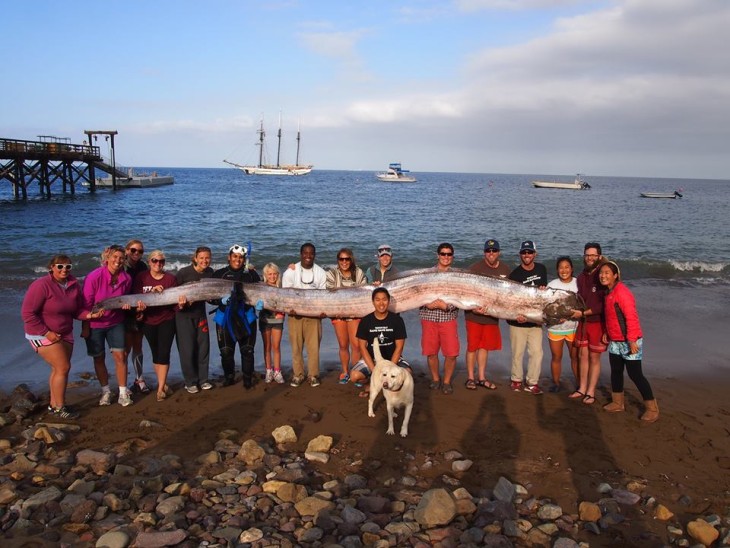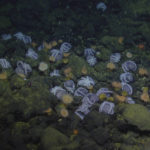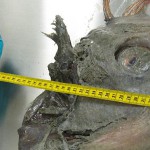Just this past week, the beaches of Southern California and Baja Mexico have been inundated by monsters from the briny deep. Well actually only one monster, the Oarfish. But it was two separate incidents! Of course you only need two data points to make a trend, so clearly there must be something wrong with the ocean it these creatures are trying to flee it. Or is there…

[source: http://www.nbcnews.com/science/18-foot-sea-monster-terrorizes-internet-oarfish-small-fry-8C11398407]

Strong northeasterly winds have been blowing the coast of Southern California since the beginning of last week. For this time of year this is sort of unusual, as the strongest northwesterly winds usually occur from May to July. But it is these fierce winds that cause deep water to be pushed upslope across the continental shelf in a process known as upwelling. Along-coast winds transfer momentum to the sea surface, pushing water which turns and flows offshore due to the influence of the Coriolis force caused by our wonderfully rotating planet. Deep water then flows up and across the continental slope to replace the surface waters that are pushed offshore, causing upwelling! Upwelling is usually a good thing, as it brings up nutrients from the deep to feed all the starving sea beasties at the surface. Upwelling is so important that often major fisheries are located around regions where upwelling occurs, such as off the coast of Chile.

[source: http://www.nwfsc.noaa.gov/research/divisions/fe/estuarine/oeip/db-coastal-upwelling-index.cfm]
A more likely scenario is that Oarfish were “tricked” by the upwelling currents to head closer to shore and shallower water when they normally wouldn’t. The bathymetry around Oceanside and Catalina island is complicated and there are many deep canyons that Oarfish could conceivably inhabit. When upwelling pushed the deep water that Oarfish typically like to hang out in up and onto the slope, they might have just tagged along, following environmental cues like temperature, salinity or even food abundance. Why they aren’t tricked onshore during the typical upwelling season is beyond me, but it might have something to do with their population distribution. Oarfish just might not be near the coast during the spring upwelling season.
As I said before, I’m not an Oarfish expert. But the victims seemed to be healthy (one lady oarfish may have been ready to spawn!), so it seems pretty likely that something caused them to want to swim towards shore at which point they weren’t able to overcome the local coastal currents and ended up gasping on the beach. Whatever the cause (and it could be that upwelling is not that cause) last weeks unlucky Oarfish just seemed to have been in the wrong place at the wrong time
ADDENDUM:
In response to the comments below, I wrote this post to suggest a real physical phenomenon for the oarfish stranding as opposed to the plethora of wild speculation that has been invading the internet. I probably didn’t put in enough “maybes” and “possiblies” to convey that properly. Further investigations may prove that upwelling may not be the cause, because that’s the way science rolls. To me it seems that wide-spread naturally occurring process is more likely to have contributed to the beachings than sonar, earthquakes or fracking fluids (if these were true, I would expect more than just two fish of the same species on the beach). I’ve even seen a suggestion that internal waves caused the oarfish to end up on the beach! For the record, I am very dubious about this claim. But regardless, upwelling is a valid and testable hypothesis and I think it would be remiss to not even consider it. Disagree? Comment section is below.






I’ve read somewhere that in Japan, it is believed that Oarfish beachings are portents of large earthquakes. Interesting to think that if that is true, where and when in the eastern Pacific will the Big Earthquake happen? Like you, I am no Oarfish expert.
This whole line of reasoning seems rather unlikely, for a number of reasons:
1. Rates of upwelling should not be rapid enough to push a large, adept swimming creature like an oarfish. The vertical velocity of upwelling is on the order of meters to tens of meters per day. I’m not sure about the horizontal velocities, but we’re not talking about a river-like current moving up the continental slope.
2. If it were not a strong current and the oarfish just “tagged along” based on environmental cues, shouldn’t another environmental cue — bright sunlight!!! — have told it to do something different and go deeper?
3. Even if upwelling did involve a strong current, the source waters for coastal upwelling are typically 50-200 meters deep. This is MUCH shallower than the normal depth range for oarfish, which may spend most of their time hanging out in the twilight zone ~500-1000 meters deep.
4. Just to play along, let’s say an oarfish living deep in a canyon swims toward the surface at night, gets entrained in an upwelling current, is confused, and swims/is washed all the way up on the beach. Why isn’t anything else getting washed up on the beach? There are many more large fish living in the mesopelagic than oarfish. It seems to me that any physical conditions that would lead to a 5 meter fish getting beached would also reveal other fantastic midwater animals on the sand.
I wish I had a good hypothesis for why two oarfish have washed up in the same place in such short time…. barring some nefarious human activity (low frequency sonar? pollution from fracking fluids?), I wonder if it could somehow be linked to a reproductive aggregation off our waters. All I know is that I can’t provide a good answer, but I think suggesting upwelling is responsible is HIGHLY unlikely.
Who knows why and I think its premature to start guessing. I think we should wait, at least until the tissue analysis is completed. We might find that the two fish succumbed to pollutants or other toxins as both appeared to be fairly young in terms of their morphology– not at mature lengths. Im anxious to see the reports when the analysis is completed.
Review by comment, I like it! To address your points:
1. Definitely forgot to mention that established upwelling currents are small, but yeah they are. And I am not convinced that upwelling pushed onshore, I even state that. But I wouldn’t completely discount it either. A couple of other pieces to keep in mind, the area is full of canyons and upwelling is enhanced in them https://circle.ubc.ca/bitstream/handle/2429/34540/Alllen_AGU_1999JC900240.pdf?sequence=1, there is a paper that suggests Santa Ana winds, which were active lately and I didn’t talk about also enhance upwelling http://bcs.cicese.mx/trasvi/Biblio/7DAO2003publicado.pdf
2. What if it was night!
3. I would argue that we don’t know enough about their depth range. And l would give a much shallower range, about 100 m, for the twilight zone based on the penetration depth of light which overlaps with the upwelling zone.
4. For all fish to end up on the beach you would have to assume that all pelagic fish have the same mobility and behavior, which I think is a poor assumption.
These are all interesting points and I definitely admit (and above to too), we definitely don’t know why they are beaching. This was just to an idea that I find more likely, then say than fracking or sonar. But just to play Devil’s advocate, if it were fracking or sonar, why don’t we see other fish beaching themselves?
Isn’t attributing their deaths to pollutants or toxins guessing too?
If you read my post, I’m not attributing their deaths to pollutants or toxins, I stated that we MIGHT find toxins or pollutants once the analysis is completed! Maybe, not will!
Fukushima…
maybe oarfish populations are booming with hyperenriched deep sea ecosystems. The beached ones could be a couple of tiddlers pushed out and beached in confusion.
It’s that or its a sign that Cthulhu is rising from His deep resting place, in which case, Ph’nglui mglw’nafh Cthulhu R’lyeh wgah’nagl fhtagn.
Or it’s Fukushima.
Nah, I agree, it can’t be Fukushima. Or Cs in general. There is a lot of solid science pointing to Fukushima Cs discharges as having few perceivable ecotoxicity effects, even at ground zero, and few broader impacts, even upon the edibility of fish. The stuff I wish I could trust is dive evidence. I’ve seen only positive articles, showing that biodiversity and numbers, even amongst hatchery species, are not showing significant changes. No-one can trust the Japanese to report accurately on ecological effects. Get thee a dry suit on and get some funding and go do a bunch of dives around the affected area. Take a whole heap of samples. Go break the real science.
Hard to imagine that radioactive isotopes are actually not that harmful in the marine environment. But who knows? There are chemists that suggest that Cs readily adsorbs onto sand and silt particles in turbid conditions, and once that has occured, the Cs is no longer bioavailable, excreted with other mineral content.
If so, I guess those guys at TEPCO should be silting the hell out of discharges as a minimum first aid effort